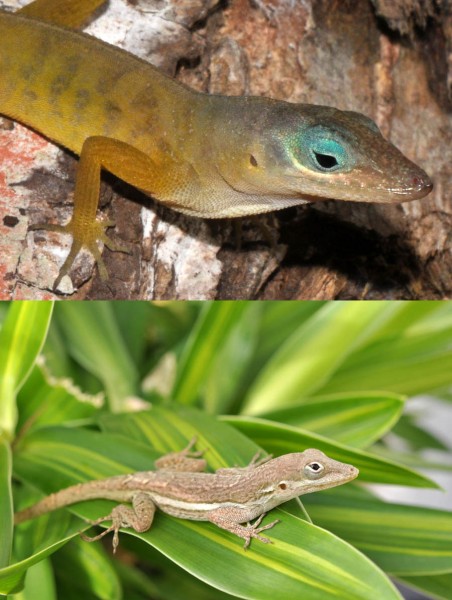On St. Martin, we have two native species of Anolis lizards, Anolis pogus (top in the photo) and Anolis gingivinus (bottom in the photo). They are both considered part of the “bimaculatus” group of anoles that live in the Northern Lesser Antilles, and as such are generally thought to come from a common ancestor arriving from the Greater Antilles.
It is probably not the case that a common ancestor arrived on St. Martin and then diverged into two species. This would be difficult because they would be able to interbreed, which would keep them from diverging. It is more likely that ancestral anoles colonized the various islands and adapted to local conditions and diverged into new species, perhaps one species on each island or island bank. Subsequently, some of these distinct species may have colonized neighboring islands, creating two species islands, where competitive pressure may have created further evolutionary change.
This process, by which anoles became new species by adapting to different environmental and competitive conditions and then colonized neighboring islands, may have happened many times throughout prehistory, gradually creating the native species we have in the Lesser Antilles today. It is also possible that this process would have continued until some islands had more than two native species. I say “would have” because most recent colonists have been introduced by humans. On St. Martin, we have two species from other parts of the Caribbean that have established populations on the island. If these are able to survive and colonize larger parts of the island, they may change the competitive dynamics of our Anolis lizards, but it would be the result of humans, not natural events.
On a different note, one might say that there are similarities between the development of biological diversity in the Lesser Antilles and the development of cultural diversity in the Lesser Antilles. Although there are many differences between the two, I think it would be reasonable to say that the various islands evolved unique cultural traditions, but also cross-pollinated between islands. During the modern tourism era, there has also been a sharp increase in the influx of cultural traditions from other parts of the world, which could be compared to the sharp increase in introduced species from other parts of the world.

